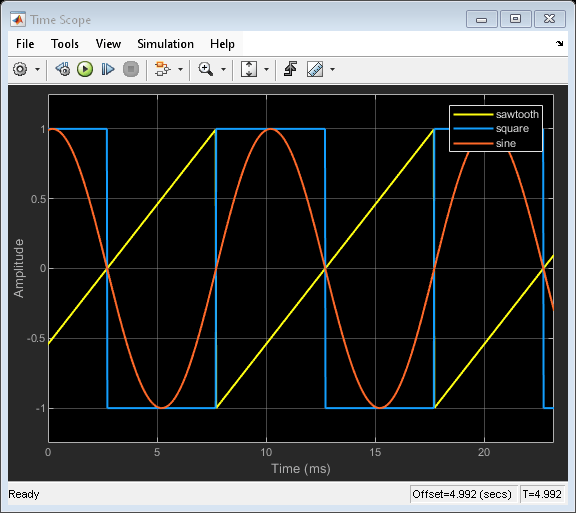Audio Oscillator
Generate sine, square, and sawtooth waveforms
Libraries:
Audio Toolbox /
Sources
Description
The Audio Oscillator block generates tunable waveforms. Typical uses include the generation of test signals for test benches, and the generation of control signals for audio effects. Parameters of the Audio Oscillator block specify the type of waveform generated.

Examples
Generate Variable-Frequency Tones in Simulink
Examine the Audio Oscillator block in a Simulink® model and tune the parameters.
Ports
Input
Dependencies
To enable this port, select Specify frequency from input port for the Frequency (Hz) parameter.
Data Types: single | double
Dependencies
To enable this port, select Specify amplitude from input port for the Amplitude parameter.
Data Types: single | double
Dependencies
To enable this port, select Specify DC offset from input port for the DC offset parameter.
Data Types: single | double
Output
The Audio Oscillator block outputs a periodic signal defined by the parameters of the block.
Data Types: single | double
Parameters
If a parameter is listed as tunable, then you can change its value during simulation.
If Signal type is set to
sine, specify Frequency (Hz) as a scalar or as a vector. If Frequency (Hz) is set to an N-element vector, then the output from the block is the single-channel sum of N sinusoids. If Frequency (Hz) is set to an N-element vector, then Amplitude, Phase offset, and DC offset must be scalars or N-element vectors.For square waveforms, specify Frequency (Hz) as a scalar.
For sawtooth waveforms, specify Frequency (Hz) as a scalar.
To specify Frequency (Hz) from an input port, select Specify frequency from input port.
Tunable: Yes
If Signal type is set to
sine, specify Amplitude as a scalar or as a vector. If Amplitude is set to an N-element vector, then the output from the block is the single-channel sum of N sinusoids. If Amplitude is set to an N-element vector, then Frequency (Hz), Phase offset, and DC offset must be scalars or N-element vectors.For square waveforms, specify Amplitude as a scalar.
For sawtooth waveforms, specify Amplitude as a scalar.
To specify Amplitude from an input port, select Specify amplitude from input port.
Tunable: Yes
The phase offset range, [0,1], corresponds to a normalized 2π
radians interval.
If Signal type is set to
sine, specify Phase offset as a scalar or as a vector. If Phase offset is set to an N-element vector, then the output from the block is the single-channel sum of N sinusoids. If Phase offset is set to an N-element vector, then Frequency (Hz), Amplitude, and DC offset must be scalars or N-element vectors.For square waveforms, specify Amplitude as a scalar.
For sawtooth waveforms, specify Amplitude as a scalar.
If Signal type is set to
sine, specify DC offset as a scalar or as a vector. If DC offset is set to an N-element vector, then the output from the block is the single-channel sum of N sinusoids. If DC offset is set to an N-element vector, then Frequency (Hz), Amplitude, and Phase offset must be scalars or N-element vectors.For square waveforms, specify Amplitude as a scalar.
For sawtooth waveforms, specify Amplitude as a scalar.
To specify DC offset from an input port, select Specify DC offset from input port.
Tunable: Yes
Square waveform duty cycle is the percentage of one period in which the waveform is above the median amplitude. A duty cycle value of 1 or 0 is equivalent to a DC signal.
Dependencies
To enable this parameter, set Signal type to
square.
Sawtooth width determines the point in a sawtooth waveform period at which the maximum occurs.
Dependencies
To enable this property, set Signal type to
sawtooth.
Number of samples per frame, specified as a positive integer.
The sample rate must be greater than twice the value specified in Frequency (Hz).
Data type of generated waveform, specified as double or
single.
Tunable: No
Code generation– Simulate the model using generated C code. The first time you run a simulation, Simulink® generates C code for the block. The C code is reused for subsequent simulations, as long as the model does not change. This option requires additional startup time, but the speed of the subsequent simulations is comparable toInterpreted execution.Interpreted execution– Simulate model using the MATLAB® interpreter. This option reduces startup time and the simulation has speed comparable toCode generation. In this mode, you can debug the source code of the block.
Block Characteristics
Data Types |
|
Direct Feedthrough |
|
Multidimensional Signals |
|
Variable-Size Signals |
|
Zero-Crossing Detection |
|
Extended Capabilities
C/C++ Code Generation
Generate C and C++ code using Simulink® Coder™.
Version History
Introduced in R2020a
See Also
Wavetable Synthesizer | audioOscillator | Audio Device Writer
MATLAB Command
You clicked a link that corresponds to this MATLAB command:
Run the command by entering it in the MATLAB Command Window. Web browsers do not support MATLAB commands.
选择网站
选择网站以获取翻译的可用内容,以及查看当地活动和优惠。根据您的位置,我们建议您选择:。
您也可以从以下列表中选择网站:
如何获得最佳网站性能
选择中国网站(中文或英文)以获得最佳网站性能。其他 MathWorks 国家/地区网站并未针对您所在位置的访问进行优化。
美洲
- América Latina (Español)
- Canada (English)
- United States (English)
欧洲
- Belgium (English)
- Denmark (English)
- Deutschland (Deutsch)
- España (Español)
- Finland (English)
- France (Français)
- Ireland (English)
- Italia (Italiano)
- Luxembourg (English)
- Netherlands (English)
- Norway (English)
- Österreich (Deutsch)
- Portugal (English)
- Sweden (English)
- Switzerland
- United Kingdom (English)
